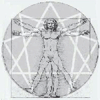“Seven cosmoses, taken together in their relation to one another, alone represent a complete picture of the universe. The idea of two analogous cosmoses, accidentally preserved from a great and complete teaching, is so incomplete that it can give no idea whatever of the analogy between man and the world. “The teaching on cosmoses examines seven cosmoses: “The first cosmos is the PROTOCOSMOS — the first cosmos. “The second cosmos is the Ayocosmos, the holy cosmos, or the Megalocosmos, the ‘great cosmos.’ “The third cosmos is the Macrocosmos — the ‘large cosmos.’ “The fourth cosmos is the Deuterocosmos — the ‘second cosmos.’ “The fifth cosmos is the Mesocosmos — the ‘middle cosmos.’ “The sixth cosmos is the Tritocosmos — the ‘third cosmos.’ “The seventh cosmos is the Microcosmos — the ‘small cosmos.’ “The PROTOCOSMOS is the Absolute in the ray of creation, or world 1. The Ayocosmos is world 3 (‘all worlds’ in the ray of creation). The Macro-cosmos is our starry world or the Milky Way (world 6 in the ray of creation). The Deuterocosmos is the sun, the solar system (world 12). The Mesocosmos is ‘all planets’ (world 24), or the earth as the representative of the planetary world. The Tritocosmos is man. The Microcosmos is the ‘atom.’ Fragments: Ten
“All that you have said,” I said, “refers without doubt to the problems of dimensions. But before I pass to them, I should like to elucidate one point, which is not quite clear to me. It is what you said about the Microcosmos. We are accustomed to connect the idea of the Microcosmos with man. This means that man represents a world in himself. A world analogous to the large world, the Macrocosmos. But you give man the name of Tritocosmos, that is, the third cosmos. Why third? The first is PROTOCOSMOS; the second, the sun or Deuterocosmos. Why is man the third cosmos?” Fragments: Ten
“If we adopt this point of view, we shall have to admit that the relation of one cosmos to another is the relation of two bodies of different dimensions. If one cosmos is three-dimensional then the next cosmos, that is, the one above it, must be fourdimensional, the next — five-dimensional, and so on. If we take the ‘atom’ or ‘microbe,’ as you say, that is, the Microcosmos as a point, then relative to this point man will be a line, that is, a figure of one dimension. The next cosmos, the earth, will be a plane relative to man, that is, it will have two dimensions, as is actually the case for direct perception. The sun, the solar system, will be three-dimensional for the earth. The starry world will be four-dimensional for the sun. ‘All worlds’ are five-dimensional, and the Absolute or PROTOCOSMOS is six-dimensional. Fragments: Ten
“Therefore parallel with this, all the possibilities of the Mesocosmos are realized in the Ayocosmos and all the possibilities of the Deuterocosmos, or the sun, are realized in the PROTOCOSMOS or the Absolute. Fragments: Ten
“Beyond the sun, that is, beyond the solar system, he has not and cannot have any existence, or in other words, from the point of view of the next cosmos he does not exist at all. A man does not exist at all in the Macrocosmos. The Macrocosmos is the cosmos in which the possibilities of the Tritocosmos are realized and man can exist in the Macrocosmos only as an atom of the Tritocosmos. The possibilities of the earth are actualized in the Megalocosmos and the possibilities of the sun are actualized in the PROTOCOSMOS. Fragments: Ten

